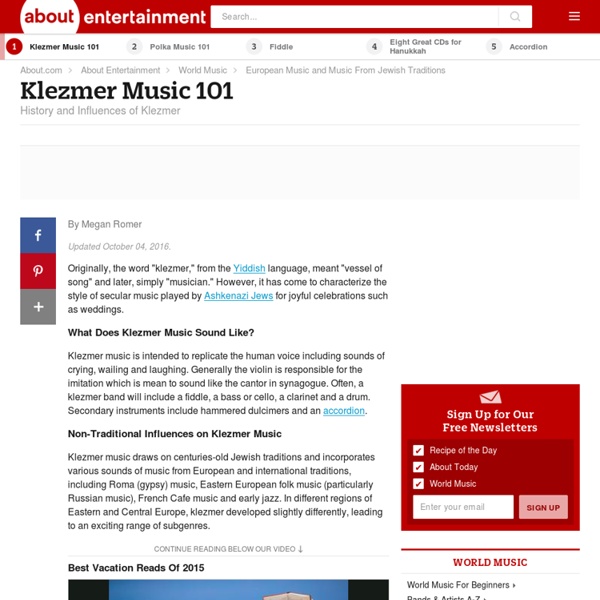What is Jewish Music?
Jewish music stems from ancient prayer chants of the Levant some 3000 years ago. The musical notation that developed and that we find in the bible today is one of the most ancient forms of notated music, and yet it is still in current practice all over the world today. Jewish music has been constantly adapting to new conditions and yet retaining its identity in many widely differing ethnic, social and religious environments.
Klezmer
Style of Jewish music Klezmer (Yiddish: כליזמר or קלעזמער (klezmer), pl.: כליזמרים (klezmorim) – instruments of music) is a musical tradition of the Ashkenazi Jews of Eastern Europe. Played by professional musicians called klezmorim in ensembles known as kapelye, the genre originally consisted largely of dance tunes and instrumental display pieces for weddings and other celebrations. In the United States the genre evolved considerably as Yiddish-speaking Jewish immigrants from Eastern Europe, who arrived between 1880 and 1924,[1] came into contact with American jazz.
Peruvian Music
The Peru music is a fusion of sounds and styles drawing on Peru's Andean, Spanish, and African roots. After hundreds years of cultural mixing, there have been created a broad musical landscape over Peru. Typical instruments used are, for example, the flute and the antara or zampoña, the box and the traditional guitar, which in Peru has also a smaller variant, known as the "charango" and mandolin.
Music of Indonesia
The music of Indonesia demonstrates its cultural diversity, the local musical creativity, as well as subsequent foreign musical influences that shaped contemporary music scenes of Indonesia. Nearly thousands of Indonesian islands having its own cultural and artistic history and character.[1] This results in hundreds of different forms of music, which often accompanies by dance and theatre. Traditional regional musics and songs of Indonesia natively compromises of strong beat and harmony type musics with strong influence of California and Malay classical music.
About Japanese Music
The earliest forms of music were drums and flute music accompanying the kagura shrine dances. From the 6th century on, music came from Korean and Chinese courts and monasteries and was performed at the Japanese court under the generic name gagaku (court music). The 8th-century court established a music bureau (gagakuryo) to be in charge of musical duties, both ritual and entertainment.
What is celtic music?
The term 'celtic music' is a rather loose one; for the purpose of Ceolas, it covers the traditional music of the celtic countries - Ireland, Scotland, Wales, Brittany (in France), Galicia (in Spain) and areas which have come under their influence, such as the US and the maritime provinces of Canada, as well as some newer music based on the tradition from these countries. The term is sometimes controversial. For starters, the Celts as an identifiable race are long gone, there are strong differences between traditional music in the different countries, and many of the similarities are due to more recent influences. There is also the notion that 'celtic' implies celtic mysticism and a particular influence in new-age music which has little to do with traditional music. In general, the strongest connections are between Irish and Scottish tradition and it is on these that Ceolas concentrates.
Cajun Music: Alive and Well in Louisiana
By Ann Savoy One of French Louisiana's most vital attractions is its music. Acadian music has undergone vast changes since arriving in Louisiana, to a large extent because those who play it today live so differently from earlier residents.
Tejano music
Tejano music or Tex-Mex music (Texan-Mexican music) is the name given to various forms of folk and popular music originating among the Mexican-American populations of Central and Southern Texas. With roots in the late 19th century, it became a music genre with a wider audience in the late 20th century thanks to artists such as Selena (often referred to as "The Queen of Tejano"), Mazz, La Mafia, La Sombra, Elida Reyna, Elsa García, Laura Canales, Oscar Estrada, Jay Perez, Emilio Navaira, Gary Hobbs, Shelly Lares, Stefani Montiel, David Lee Garza, Jennifer Peña, and La Fiebre. Origins[edit] Europeans from Germany (first during Spanish time and 1830s), Poland, and what is now the Czech Republic migrated to Texas and Mexico, bringing with them their style of music and dance. They brought with them the waltz, polkas, and other popular forms of music and dance.
Native American music
Native American music. The music of Native North Americans is primarily a vocal art, usually choral, although some nations favor solo singing. Native American music is entirely melodic; there is no harmony or polyphony, although there is occasional antiphonal singing between soloist and chorus. The melody is, in general, characterized by a descending melodic figure; its rhythm is irregular. There is no conception of absolute pitch and intonation can appear uncertain, the result of the distinctive method of voice production, involving muscular tension in the vocal apparatus and making possible frequent strong accents and glissandos. Singing is nearly always accompanied, at least by drums.
reggae
Reggae, style of popular music that originated in Jamaica in the late 1960s and quickly emerged as the country’s dominant music. By the 1970s it had become an international style that was particularly popular in Britain, the United States, and Africa. It was widely perceived as a voice of the oppressed. According to an early definition in The Dictionary of Jamaican English (1980), reggae is based on ska, an earlier form of Jamaican popular music, and employs a heavy four-beat rhythm driven by drums, bass guitar, electric guitar, and the “scraper,” a corrugated stick that is rubbed by a plain stick. (The drum and bass became the foundation of a new instrumental music, dub.) The dictionary further states that the chunking sound of the rhythm guitar that comes at the end of measures acts as an “accompaniment to emotional songs often expressing rejection of established ‘white-man’ culture.”
GCSE Bitesize: African music



